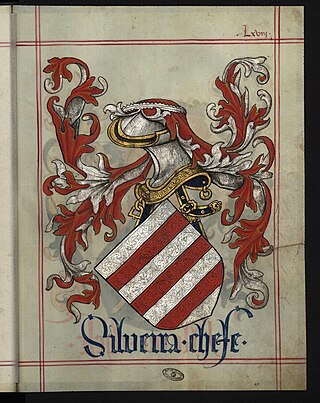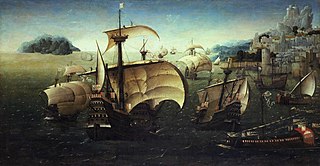
Afonso de Albuquerque, 1st Duke of Goa, was a Portuguese general, admiral, and statesman. He served as viceroy of Portuguese India from 1509 to 1515, during which he expanded Portuguese influence across the Indian Ocean and built a reputation as a fierce and skilled military commander.

The Austro-Turkish War (1716–1718) was fought between Habsburg monarchy and the Ottoman Empire. The 1699 Treaty of Karlowitz was not an acceptable permanent agreement for the Ottoman Empire. Twelve years after Karlowitz, it began the long-term prospect of taking revenge for its defeat at the Battle of Vienna in 1683. First, the army of Turkish Grand Vizier Baltacı Mehmet defeated Peter the Great's Russian Army in the Russo-Turkish War (1710–1711). Then, during the Ottoman–Venetian War (1714–1718), Ottoman Grand Vizier Damat Ali reconquered the Morea from the Venetians. As the guarantor of the Treaty of Karlowitz, the Austrians threatened the Ottoman Empire, which caused it to declare war in April 1716.

José Lúcio Travassos Valdez, only Baron and first Count of Bonfim, was a Portuguese soldier and statesman.
António de Saldanha was a Castilian-Portuguese 16th-century captain. He was the first European to set anchor in what is now called Table Bay, South Africa, and made the first recorded ascent of Table Mountain.

The Federalist Revolution was a civil war that took place in southern Brazil between 1893 and 1895, fought by the federalists, opponents of Rio Grande do Sul state president, Júlio de Castilhos, seeking greater autonomy for the state, decentralization of power by the newly installed First Brazilian Republic.

The siege of Cannanore was a four-month siege, from 27 April 1507 to 27 August 1507, when troops of the local ruler, supported by the Zamorin of Calicut and Arabs, besieged the Portuguese garrison at St. Angelo Fort in Cannanore, in what is now the Indian state of Kerala. It followed the Battle of Cannanore, in which the fleet of the Zamorin was defeated by the Portuguese.
The 4th Portuguese India Armada was a Portuguese fleet that sailed from Lisbon in February, 1502. Assembled on the order of King Manuel I of Portugal and placed under the command of D. Vasco da Gama, it was the fourth of some thirteen Portuguese India Armadas, was Gama's second trip to India, and was designed as a punitive expedition targeting Calicut to avenge the numerous defeats of the 2nd Armada two years earlier.
The Fifth India Armada was assembled in 1503 on the order of King Manuel I of Portugal and placed under the command of Afonso de Albuquerque. It was Albuquerque's first trip to India. It was not a particularly successful armada - navigational mistakes scattered the fleet on the outward journey. Ships spent much time looking for each other and several ended up travelling alone.
The Sixth India Armada was assembled in 1504 on the order of King Manuel I of Portugal and placed under the command of Lopo Soares de Albergaria.

The Battle of Cochin, sometimes referred as the Second Siege of Cochin, was a series of confrontations, between March and July 1504, fought on land and sea, principally between the Portuguese garrison at Cochin, allied to the Trimumpara Raja, and the armies of the Zamorin of Calicut and vassal Malabari states.

The Castle/Fortress of Almeida is a castle situated in the civil parish of Almeida, in the municipality of Almeida in the Portuguese district of Guarda, in the former-northwestern province of Beira Alta. It was constructed in this region due to its significant strategic importance, due to its close proximity to the border between Portugal and Spain. It is classified as a National Monument. The 1810 explosion: the magazine which was the seat of the explosion was in the cathedral adjacent to the castle, not the castle itself as reported in the text.

João da Silveira was the first Captain of Portuguese Ceylon. Silveira was appointed in 1518 under Manuel I of Portugal. He was succeeded by Lopo de Brito.

The War of the League of the Indies was a military conflict lasting from December 1570 to 1575, wherein a pan-Asian alliance attempted to overturn the Portuguese presence in the Indian Ocean. The pan-Asian alliance was formed primarily by the Sultanate of Bijapur, the Sultanate of Ahmadnagar, the Kingdom of Calicut, and the Sultanate of Aceh. It is referred to by the Portuguese historian António Pinto Pereira as "the League of Kings of India", "the Confederated Kings", or simply "the League". The alliance undertook a combined assault against some of the primary possessions of the Portuguese State of India: Malacca, Chaul, the Chale fort, and the capital of the maritime empire in Asia, Goa.

The siege of Chale or siege of Chaliyam took place in 1571 as a part of the war of the league of the Indies between the Zamorin of Calicut and the Portuguese Empire. Zamorin's Calicut army successfully starved out the fortress, compelling the surrender of Portuguese captain Dom Jorge de Castro.
The siege of Kottakkal also known as the battle of Cunhale River was a military engagement between the joint forces of the Portuguese Empire and the Zamorin of Calicut against the stronghold of Kunjali Marakkar Kottakkal called by the Portuguese Forte Branco.

Gujarati–Portuguese conflicts refers to the armed engagements between the Portuguese Empire and the Sultanate of Gujarat, in India, that took place from 1508 until Gujarat was annexed by the Mughal Empire in 1573.

Adil Shahi–Portuguese conflicts refers to the various armed engagements that took place in India between the Portuguese Empire and the Sultanate of Bijapur, ruled by the Adil Shahi dynasty, whose rulers were known to the Portuguese as Hidalcão.

The First Luso–Malabarese War was the first armed conflict fought by the Portuguese Empire in Asia, and the first of nine against the Zamorin of Calicut, then the preeminent power on the Malabar Coast, in India. Hostilities broke out in 1500 and continued for thirteen years until the ruling Zamorin was assassinated and his successor signed a peace treaty with the Portuguese governor of India Afonso de Albuquerque.

Salvador Ribeiro de Sousa was an influential figure in the Early Modern Historical Period of Burma. He played a role in helping Filipe de Brito e Nicote, Nga Zinga, in defeating the Kingdoms of Arakan and Pegu, and in setting up a Pseudo-Portuguese Colony in the remnants of those kingdoms. He was awarded the Commander of the Military Order of Christ and was unofficially elected King of Pegu by the Burmese people. He also received the title "Quiay Massinga".
The Zamorin–Portuguese conflicts were a series of military engagements between the Zamorins of Calicut and the Portuguese Empire during the 16th century in the Indian Ocean.














